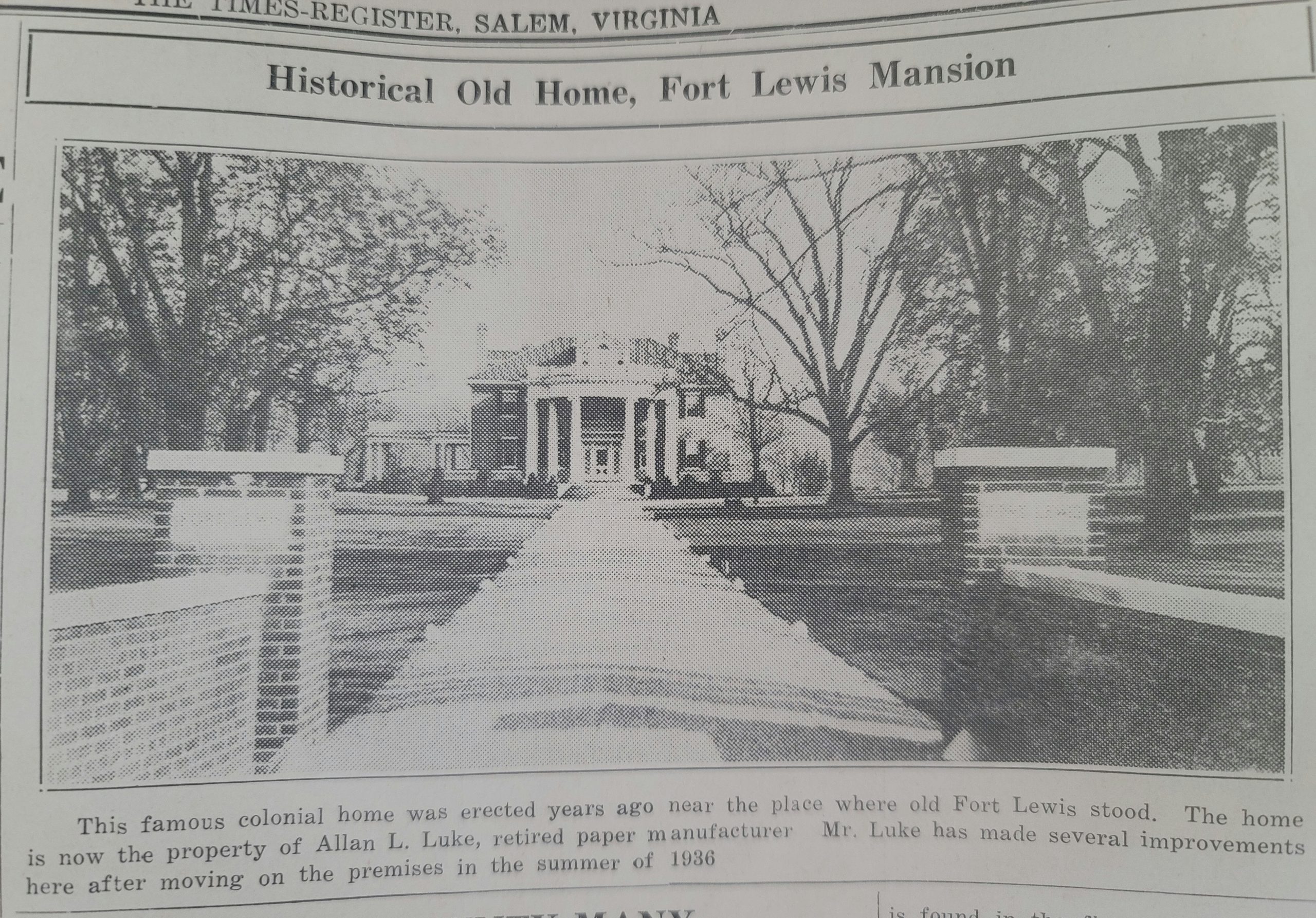
James Campbell Said To Have Acquired Land In 1742-F. B. Gordon In 1910 Did Most Of Remodeling
From the 1938 centennial edition of The Times-Register
One of the first settlers in Roanoke county was James Campbell who settled at the site of Fort Lewis in 1742. By securing two tracts of land here he formed a settlement that was destined to be one of the historic parts of the county. This was almost fifteen years before the fort was built at that placed but it marked the beginning of the Fort Lewis estate which is not to be confused with the fort itself.
In 1760 Campbell sold out to Alexander Boyd, lieutenant and paymaster to the Virginia regiment. He enlarged the estate and built a store on the premises. At the death of Boyd which occurred in 1766 the property passed into the hands of Alexander Baine, who had been one of Boyd’s sureties. In 1773 this property was secured by David Ross who obtained a new patent which showed that there were 2,200 acres in the estate.
Both David Ross and Alexander Baine were prominent merchants of Virginia and owned a number of stores on the frontier. Both must have been rather well-to-do judging by the property they acquired. In 1783 Baine was charged on the tax books with ownership of 21 horses, 87 cattle and 49 slaves. Baine died in 1800 in Montgomery county after making a will which gave freedom to his slaves.
Estate Changes Hands
In the settlement of the estate of David Ross the estate was sold to Thomas Norvell in 1806 who in turn passed it on to Samuel White. In 1827 the landed estate of Samuel White was divided and that part on which the Fort Lewis mansion was located passed to Alexander White whose family resided upon the estate for a number of years.
After the death of Alexander White, the mansion with about 150 acres of land reverted to Fannie Penn White who in turn conveyed it to W. L. Nolen. In 1909 the property was deeded to S. E. Nolen.
This historic place passed into the hands of Frank Burwell Gordon in 1910, and he completely remodeled the estate to make it one of the show-places of Roanoke county. In keeping with traditions Mr. Gordon made the architectural designs conform to the colonial period. When the remodeling was completed the setting, surroundings, building and premises became a thing of beauty. Not only is the mansion itself a stately structure but the broad avenue lined with trees makes a very attractive picture to the motorists who pass by.
Poff Boys Estate
This historic mansion remained in the possession of Gordon for years but he sold it on August 9, 1919 to W. A. Poff for a consideration of $50,000. Mr. Poff did not keep the property long for he sold it to Geo. W. Payne on December 1, 1922 for $44,900.
Allan L. Luke, retired paper mill executive purchased the home from the Payne estate in April, 1936 and in May of that year moved into the place. Mr. Luke is the son of John G. Luke who was president of the West Virginia Pulp & Paper Company of Luke, Maryland which is just across the line from West Virginia.
While the exterior of the building appears to be modeled after the early colonial homes all modern improvements have gone into the building. A small fortune was spent in making it what it is today.
Lewis Built Fort
As to the erection of the fort near this site the date of building is not definitely known. It was probably erected by Andrew Lewis in 1754 or 1755. In October, 1754, Capt. Lewis was ordered to do such ranging as seemed necessary to him and build a fortification where he could leave a force of men who would be subject to call.
The first reference made to the erection of a fort there was in 1756. When the Sandy Creek expedition was organized, William Preston gathered a number of men together at a fort which Preston designated as Fort Prince George. That this place was the same as Fort Lewis is believed by some, but Kegley in his history states the opinion that the Fort Prince George referred to by Preston was on the pass leading from Catawba to the head branches of the Roanoke forming Tinker Creek and the head springs of Looney’s Mill Creek.
References are made to forts in the early days which were only stockades and from reading early records it seems that there were different forts in various places at different times. For that reason the tracing of the history of the early forts is a rather difficult matter.
-Prepared by Lisa King





